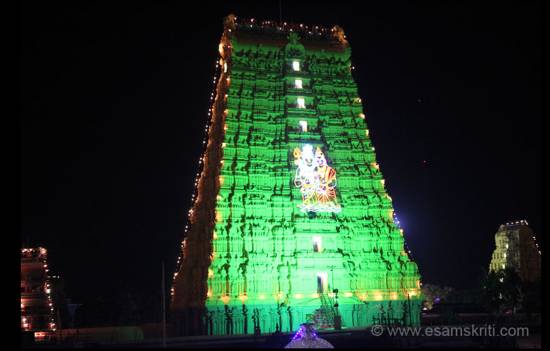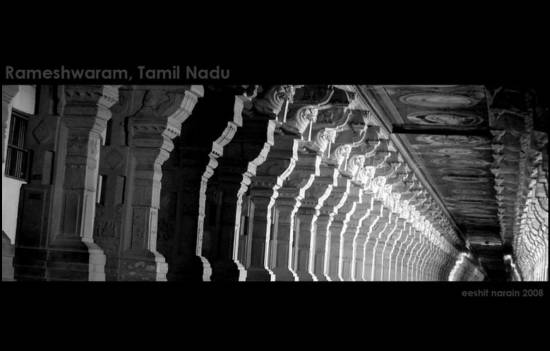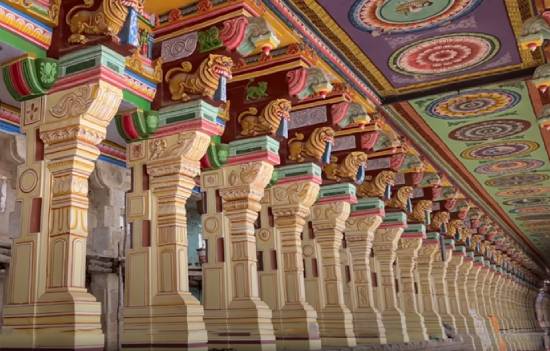- Our recent visit
to this sacred town was a spiritually enriching experience, filled with
stunning temple architecture, rich associations, and a deep sense of devotion.
Know all about the yatra.
Rameshwaram is a
destination that caters to both the devout and the curious. Whether you are a
pilgrim seeking spiritual solace or a traveler eager to explore ancient history
and architecture, Rameshwaram has something to offer everyone.
Rameshwaram is a
popular pilgrimage destination located in the south Indian state of Tamil Nadu.
It is a part of Pamban Island, connected to mainland India via the famous
Pamban Bridge.
 U can reach Rameshwaram by train (old bridge) or road. 2016.
U can reach Rameshwaram by train (old bridge) or road. 2016.
Our recent trip
to Rameshwaram was a journey through time, a confluence of tradition,
architecture, and spirituality. This island town, holds a significant place in
Hindu mythology, and steeped in the rich history and vibrant culture that
permeates every corner.
Our journey began with a visit to the magnificent Ramanathaswamy Temple, also known as the Rameshwaram Temple, a masterpiece of architecture. The temple's towering gopurams, intricate carvings, and the famed 1,212 pillars left us awestruck. The sheer scale and artistry of the structure are a testament to the devotion and craftsmanship of the people who built it.
 Illuminated Ramanathaswamy Temple.
Illuminated Ramanathaswamy Temple.
Nearby is Dhanushkodi, the 'ghost town' at the eastern tip of the island, believed to be the starting point of the Ram Setu, the bridge built by Sri Rama's army to reach Lanka. The remnants of the old town, ravaged by a cyclone in 1964, stand as a poignant reminder of the ephemeral nature of time. (album link at end)
Mythological
Significance
Rameshwaram, a
small island in the Gulf of Mannar, is a significant pilgrimage site in
Hinduism, located off the coast of Tamil Nadu, India. Our recent visit to this
sacred town was a spiritually enriching experience, filled with stunning temple
architecture, rich mythological associations, and a deep sense of devotion.
Rameshwaram's significance is deeply rooted in the epic Ramayana. According to tradition, Lord Rama, the king of Ayodhya, built a bridge (known as Rama Setu) from Rameshwaram to Lanka to rescue his wife, Sita, from the clutches of the demon king Ravana. It is believed to be the place where Lord Rama offered prayers to Lord Shiva to absolve the sin of killing Ravana.
The
temple enshrines two lingams: the Ramalingam, fashioned by Sita from sand, and
the Vishwalingam, brought from Kailash by Hanuman. Rama instructed that the
Vishwalingam be worshipped first, a tradition that continues to this day.
Later, Rama's son, Kusha, built a temple in Rameshwaram to honor his father's vow to perform the pilgrimage. The temple was built on the site where Rama is believed to have performed his austerities, and it is said that the lingam in the temple is the same one that Rama worshiped during his stay on the island.
An
Architectural Marvel
The Ramanathaswamy Temple, one of the
twelve Jyotirlingas in India, is the main attraction in Rameshwaram. This
magnificent temple, dedicated to Lord Shiva, is renowned for its stunning
architecture, which showcases the expertise of ancient Indian craftsmen. The temple is built on a high platform and
has a gopuram (tower) that is over 120 feet tall. The temple complex is
surrounded by a series of concentric walls, with the innermost wall housing the
sanctum sanctorum - home to the revered lingam of Lord Shiva.
The temple's gopurams, or towers, are adorned with sculptures of deities and celestial beings. The temple has several mandapams, or halls, each with its unique architectural features.

 Pic is from Instagram just to give you a flavour of column design. Sorry for using without permission. No credit to author.
Pic is from Instagram just to give you a flavour of column design. Sorry for using without permission. No credit to author.
The temple's long corridors, measuring over 1,200 meters, are adorned with intricate carvings and sculptures, depicting scenes from Hindu mythology. The gopurams (towering gateways) and mandapams (pillared halls) are equally impressive, with their ornate carvings and vibrant colors. The Ramanathaswamy Temple is a prime example of South Indian architecture, characterized by its towering gopurams, intricate carvings, and a vast network of pillared corridors, the longest corridor in India, with 1212 pillars.
The
22 Kund Bath
One of the most
unique and sacred experiences in Rameshwaram is the 22 Kund bath. The 22 kunds
are a series of sacred wells and tanks that are believed to have been created
by Lord Rama himself. The bath is a ritualistic purification process that is
said to wash away all sins and impurities. The bath is typically taken early in
the morning, and devotees can take a dip in each of the 22 kunds, which are
located around the temple complex.
The 22 Kund Bath
is a significant ritual in Hinduism, offering a unique opportunity for devotees
to purify their body and soul, invoke the blessings of Lord Shiva, and connect
with the divine feminine energy of Shakti. By performing this ritual, devotees
can experience spiritual growth, balance their astrological energies, and seek
liberation from the cycle of birth and death.
The 22 kunds are
not merely water bodies; they are sacred sites imbued with divine energy.
Bathing in them is an act of faith, a ritual of purification, and a way to
connect with the rich mythology and spiritual heritage of Rameshwaram.
Legend has it that these kunds were created by Lord Rama himself. It is said that he used his arrows to create these wells to quench the thirst of his army after the battle with Ravana. The number 22 is also believed to represent the 22 arrows in Lord Rama's quiver.
Each kund is
associated with a specific deity or virtue, and bathing in its waters is
believed to invoke that particular blessing. For instance, the Mahalakshmi
Theertham is associated with prosperity, while the Saraswathi Theertham is
believed to enhance knowledge and wisdom.
 Courtesy Blogger.com Source link
Courtesy Blogger.com Source link
 Could not find source. Sorry for using without permission. Author not clicked.
Could not find source. Sorry for using without permission. Author not clicked.
The 22 kunds are
also associated with the 22 Shakti Peethas, which are sacred sites in Hinduism
where the goddess Shakti is worshiped. The kunds are believed to be connected
to these peethas, and bathing in them is thought to
bring the devotee closer to the divine feminine energy of Shakti. Each
of the 22 kunds is associated with a specific planet or astrological influence.
By bathing in these kunds, devotees are believed to be able to balance their
astrological energies and mitigate the negative effects of planetary
influences.
 Some devotees take a dip in the sea i.e. minutes away from temple.
Some devotees take a dip in the sea i.e. minutes away from temple.
Conclusion
Rameshwaram is a
place of immense spiritual significance and beauty. The temple architecture,
the 22 Kund bath, and the mythological associations all come together to create
a unique and unforgettable experience. Whether you are a devout Hindu or simply
a curious traveler, Rameshwaram is a place that is sure to leave a lasting
impression on your heart and soul.
To read all
articles by author
To see albums of
Shiv Temples
Also see
albums
1. Rameshwaram
Temple
2. Rameshwaram
Temple 2
3. Dhanuskodi
Island
4. Ramayana around Rameshwaram